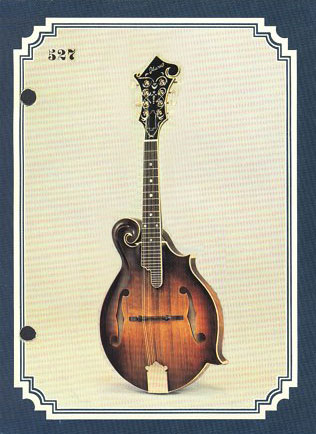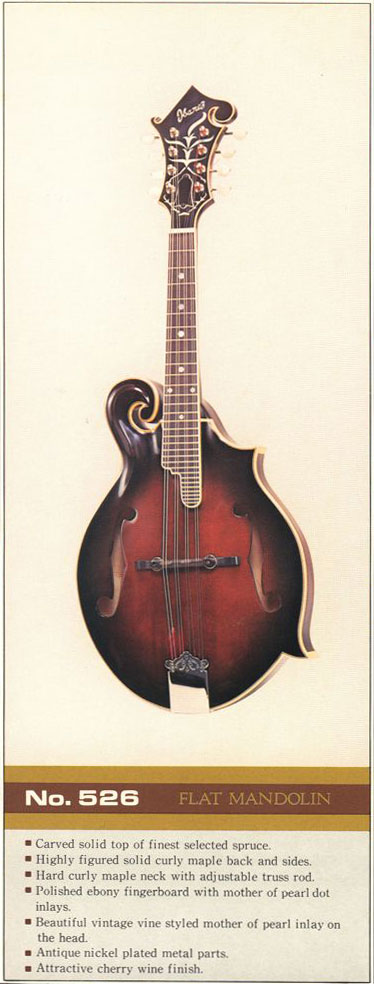
The first important distinction among Ibanez mandolins is the series. Mandolins of the 52X series, like the 524 and 527, featured all solid wood construction and carved tops. They are the focus of this website. Mandolins of the 51X series, such as the 513, were lower quality with cheaper parts, and are therefore not of as much interest and will not be covered on this web site.
Within the 52X series there are eleven models: 521, 522, 523, 524, 524CW, 524AV, 525, 526, 527, plus the later 528 and 529. For the purpose of discussion, we will group them into 4 categories, based on their features and rarity. These groups are not official but have some basis in the Ibanez catalogs of the time which designated the 524 model “Artist” and the 523 model “Pro”.
Learn more about dating an Ibanez Mandolin through Ibanez Mandolin Serial Numbers

Ibanez Mandolin Models
Master Models: 527, 526
Made in smaller numbers to a higher spec, with some distinguishing construction and finish features. The 526 and 527 have a different neck joint with binding across the joint, feature fancy peghead inlay, and lack a pickguard.
Modern Models: 529, 528
Manufactured from about 1980 to 1982, after the other models ceased production, the 529 and 528 mandolins use a completely original design and have a slightly longer case.
Artist Models: 524, 524CW, 524AV, 525
Made in larger quantities with slightly lesser features, the 524 and 524CW are the most common vintage Ibanez mandolin. All 4 models feature the “fancy” fingerboard inlay and standard neck joint. The 524CW is simply a 524 in a “Cherry Wine” finish. The 524AV is a 524 with an upgraded, hand-rubbed “Antique Violin” finish. Model 525 is an oval-hole F-4 style.
Pro Models: 523, 522, 521
More features are removed to create a player’s mandolin and hit a lower price point. The 523 is a stripped down F-5 with no headstock overlay and simple block inlays. The 522 and 521 are variants of Gibson A-style mandolins.
Ibanez Mandolin Models in Detail
Master Models: 527
The 527 is the “true” Ibanez Bill Monroe model, and as close as Ibanez came to an actual copy of a Gibson Lloyd Loar style F-5 mandolin. The highest grade of woods was used on the 527 models and you will see a variety of highly figured maple in the back, sides, and neck: curl, quilt, birdseye, and flame. The solid spruce top is typically tight grained and of extremely high quality.
The deep, hand-rubbed finish highlights the quality of the wood and imparts a unique, vintage appearance that differs considerably from the standard sunburst of the more common 524 models. The color of the sunburust was used only on the 527 and seems to accentuate a deeper top carve. Dot fingerboard inlays are true to the Loar design, although the fancy and unusual headstock inlay is not. Note how the binding continues straight across the neck joint which is a more complex construction technique than what Ibanez used on their Artist and Pro mandolins where the binding simply follows the outline of the mandolin top.
Other features include nickel hardware and no pickguard.

Master Models: 526
In terms of construction, the 526 is a near identical sister to the 527. All of the high end structural features are there like the neck joint and deep top carve, although the wood figure is typically not as vivid. This may have to do with the darker cherry wine finish.
The only real differences between the 526 and 527 are cosmetic. The 526 features a very attractive “Fern” style headstock inlay, nickel plated hardware, and the cherry wine finish color. The 526 came from the factory without a pickguard.

Modern Models: 528
The less fancy version of the Modern mandolin series by Ibanez, the 528 was the last model added to the Ibanez lineup circa 1982. It is a plainer version of the 529.
There is likely some difference in the finish process between the 528 and 529. We await a side by side comparison for more details.

Modern Models: 529
The 529 appears in both the 1980 and 1982 mandolin catalogs. Initally, the model featured a dot inlay fingerboard, as shown in the 1980 Ibanez Mandolin Catalog.
The later version in the 1982 catalog shows a fancy fingerboard inlay, likely used to distinguish it from the newly introduced, cheaper 528 mandolin which had a dot inlay fingerboard.
The 529 is part of what I call the “Modern Series” of Ibanez mandolins. By the 1980′s, Ibanez had reached a point where they were no longer directly copying Gibson designs but developing original designs. The snakehead and hollow scroll are unlike any previous models. Although not a direct copy, some inspiration from the work of John Monteleone, who was a prominent luthier at the time, and Gibson lump scroll models is evident.
The striking hand-rubbed Antique Violin finish was reserved for the most high-end Ibanez instruments, and the dramatic top carve is reminiscent of the 527. Note the unusual shape of the f-holes. The overall effect is a very high-end instrument with excellent craftsmanship.

Artist Models: 524
The most common of the F-5 mandolins made by Ibanez. The 524 is based on the classic Gibson F-5 mandolin, but not the one you probably think. Rather than copy the timeless 1920′s Lloyd Loar version of the F-5, the 524 is based more on the 1970′s Gibson F-5, which was probably a lot easier to find at the time to use as a manufacturing reference. Like a 1970′s Gibson, the Ibanez features a fancy fingerboard inlay and similar finish and binding cosmetics. Gold hardware and bound tortoise pickguard round out the package.
The gorgeous faux tortoiseshell headstock overlay is unique to the 524 models, and the overall effect is of a well-appointed and finely crafted mandolin. As the workhorse of the model range, the 524 is a dependable and excellent sounding mandolin of professional quality. With proper care it will provide a lifetime of great music.
Like the 1970′s Gibson, the mandolin was finished in “Cremona Brown Sunburst” which translates to several variations of the classic tobacco sunburst, brown at the edges fading to golden at the center.

Artist Models: 524CW
Identical to the 524 model with the exception of the cherry wine finish. This is a deep burgundy all-over color that tends to hide the figure in the wood a bit. The 524CW seems to have been produced in similarly large quantities to the 524. The mandolin should be marked CW on the interior label if it has one.
The color of the catalog image above, which shows a burst on the edges of the mandolin, is not really accurate.

Artist Models: 524AV
No catalog image has yet been found for this model. The 524AV was a 524 model with an upgraded Antique Violin finish. Ibanez charged an extra $25 over the cost of a 524, according to the 1977 price list.
Artist Models: 525
With its oval soundhole, the Model 525 is based on a Gibson F-4 mandolin. It is otherwise nearly identical to the 524 model. One exception would be the headstock cosmetics: the 525 lacks the tortoiseshell overlay and has no binding on its plain black headstock.
Perhaps because of the lower demand for an oval-holoe mandolin and therefore lower production numbers, the 525 seems to be a bit harder to find than the common 524.

Check out our extensive resource of Free Mandolin Tabs
Mandolin Interviews
Trevor Moyle Interview
Alon Sariel Interview
Dan Beimborn Interview
Kevin Macleod Interview
Dagger Gordon Interview
Alison Stephens Interview
Gary Peterson Interview
Ian Harris Interview
